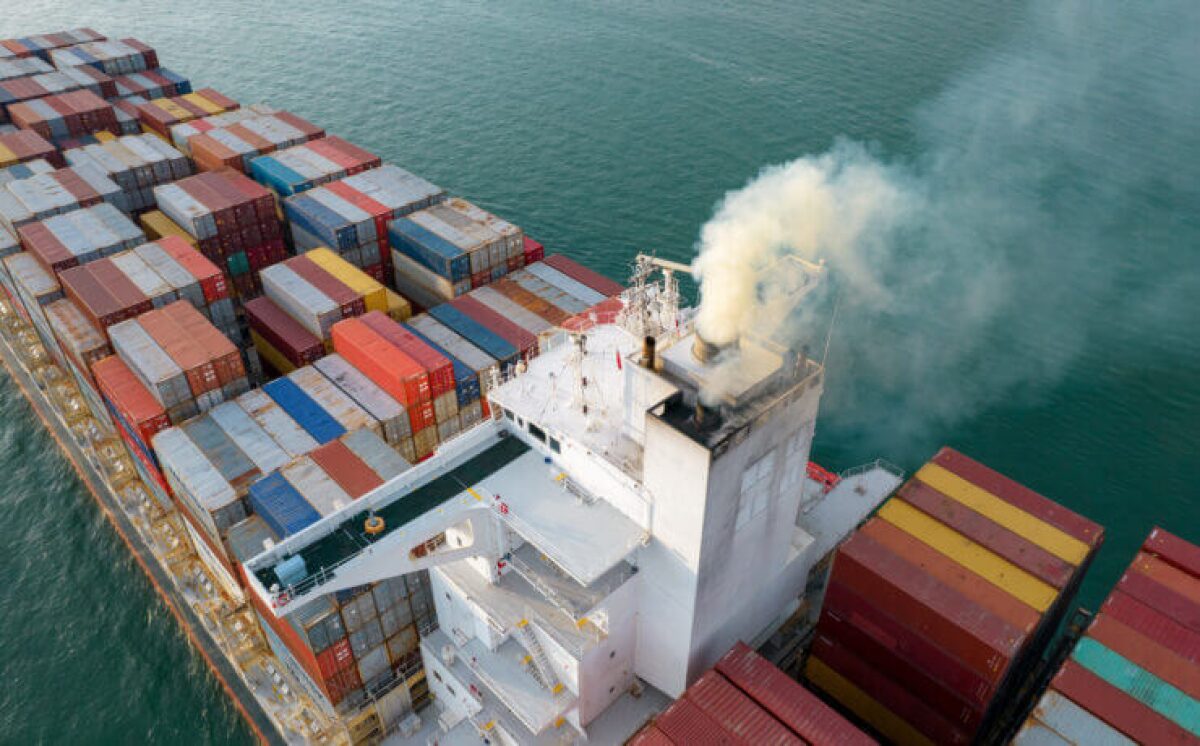International Shipping Meeting to Target Greenhouse Gas Emissions

Image – Exhaust from a large container ship. Credit: Adobe Stock
By: Ruth Teichroeb
September 20, 2024
Oceans North is attending International Maritime Organization (IMO) meetings on greenhouse gas emissions in London next week. We sat down with Amy Nugent, Associate Director of Marine Climate Action, to talk to her before she left for the meetings and asked her about the key issues under discussion.
What is the IMO, and how does it affect the work of Oceans North and Canada’s maritime industry?
The IMO is the part of the United Nations responsible for the governance of shipping and safety-related issues. “Safety” includes air pollutants caused by shipping, greenhouse gas (GHG) emissions, marine spills, noise, and access to sensitive Arctic waters. At the IMO meetings in London, international leaders will be discussing important issues such as reducing GHG emissions from ships, enhancing energy efficiency, managing ballast water, and reducing underwater noise. I am proud to attend as a Canadian and contribute to these crucial conversations for the future of our oceans and global shipping.
How does Canada’s participation in the IMO meetings help shape international shipping regulations?
Canada has the opportunity to exert quite a bit of influence this year and next year. Our government is a member of the Executive Council of the IMO that sets the agenda and oversees its progress. A lot of Canadians, especially those who don’t live on the coast, might not realize how hugely important shipping is to our economy, trade, and livelihoods. But in 2022, marine trade globally was worth $345 billion and almost 30,000 Canadians worked directly in the maritime sector.
Ports and marine shipping were involved in bringing almost $151 billion of Canada’s exports to world markets and imported even more into our country. That includes goods, commodities, and people who travel on ships through sensitive waters and ecosystems. Before working for Oceans North, I did not appreciate the magnitude or realize how ports, in many ways, set a metabolic rhythm for trade. Oceans North sees a role for ports to set that same rhythm for environmental protection and GHG reductions.
What specific outcomes are you hoping for from these IMO meetings regarding GHG reductions?
Canada has made some progress in terms of reducing GHGs and energy switching over the last decade. For example, Ontario and Alberta have phased out coal-fired electricity. Nationally, we have legislated emissions reduction targets that apply across the economy. And most industrial sectors have significant reporting and emissions reductions requirements, with large public incentives available to help make change.
Up until recently, shipping and marine industries have really been left on the sidelines as a so-called “hard-to-decarbonize” sector. But there are proven energy efficiency technologies available now that could dramatically reduce both GHG emissions and air pollution from these activities. For example, we could be requiring and incentivizing ships to shut off diesel engines when at berth and plug into the power grid instead.
How does this relate to the IMO? Last year, the IMO adopted a new Strategy on Reduction of GHG Emissions from Ships to achieve net-zero emissions by 2050 and cut emissions by at least 40 per cent by 2030. The Strategy also includes a requirement that zero-emission marine fuels be 5 to 10 per cent of the energy used by international shipping by 2030. The Government of Canada, along with the United States and the United Kingdom, negotiated for even more ambitious targets and actions.
At this year’s IMO meeting, we hope to support Canada in keeping the IMO on track to turn last year’s strategy into binding regulations that will level the global playing field, support competitiveness for our industry, and reduce emissions. This primarily means that we must see progress on three fronts: a new and robust zero-emission fuel standard; an emissions levy on global shipping; and immediate and ambitious energy efficiency actions.
One of my concerns is that the anticipation of upcoming elections in both Canada and the United States are creating a degree of volatility that has the potential to distract these countries from pushing ambitious work and progress. It must be said: our oceans are warming at an untenable rate and Canada’s forests and communities are more vulnerable to wildfires conditions, which also cause dangerous air quality for much of our summers. Our planet will not wait to see the outcome of domestic elections. We need courageous leadership from officials to push for the kinds of international actions where Canadians and Canada can be leaders—including in the supply of new zero-emission fuels.
We also want to hear about the status of domestic implementation, such as the Marine Climate Action Plan and Canada’s Green Corridor Fund for Clean Ports. With 2030 targets just around the corner, the maritime sector needs to invest the same kinds of effort, requirements, and incentives that have made progress possible in other parts of the economy.
What are zero-emission fuels, and why do IMO policies play a key role in their development and adoption?
Zero-and near-zero emission (ZNZ) fuels are fuels that produce no GHG emissions (the planet-warming gases such as carbon dioxide, methane, and nitrous oxide).
The definition of zero emission will be contested at the IMO, as member states try to arrive at a common standard for sustainable fuels. Oceans North wants to see the IMO land on and enact a very high-integrity definition that will lead to actual GHG reductions.
What do I mean by high-integrity? It means transparent, effectively measured, and stringent standards that will lead to actual GHG reductions—rather than allowing individual states to game the definition of fuels and lock in their preferred fuel without adequate respect to necessary climate action.
You also mention that the standard should be stringent. What does that mean?
These fuels need to emit zero– or near-zero emissions. Period. To meet Canada’s targets of 40 per cent emissions reductions by 2030 and net-zero by 2050, Oceans North wants to see a definition of zero emission that is 80-90 per cent or better in terms of reductions when compared to business-as-usual fuels. A full lifecycle accounting of emissions is critical to the credibility of ZNZ, meaning emissions are accounted for from their creation to their use—what is called “well-to-wake” instead of “tank-to-wake.” Such a definition is the best way to ensure that investments are truly on a path to zero-emissions. Businesses making investments today should drive their efforts and capital to ZNZ technologies and assets like ships, shoreside infrastructure, and energy generation infrastructure and be rewarded for that. Conversely, if the IMO sends unclear signals or rewards inferior fuels or technologies, then investments made into fuels with continued carbon intensity will be economically inefficient and environmentally dangerous.
Why is it important for Canada to focus on true zero-emission fuels rather than fossil-fuel derivatives like liquefied natural gas (LNG)?
LNG is a fossil fuel. It will reduce emissions compared to heavy diesel, but it will not help achieve the IMO 2023 Strategy nor meet the emissions targets set in the Paris Agreement. We need to drive investment and commercialization efforts to those technologies, practices, and fuels that will reach net-zero not only in the marine sector, but across any and every sector of the economy.
Ruth Teichroeb is a regular contributor to Oceans North and former communications director. She lives in Sidney, B.C.
